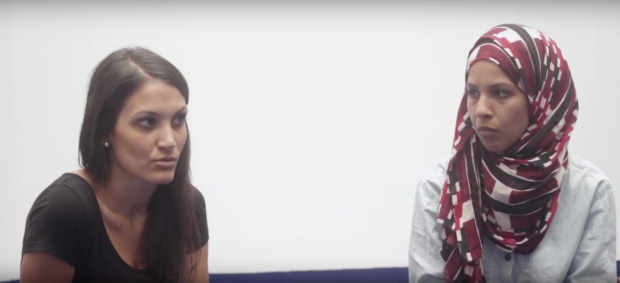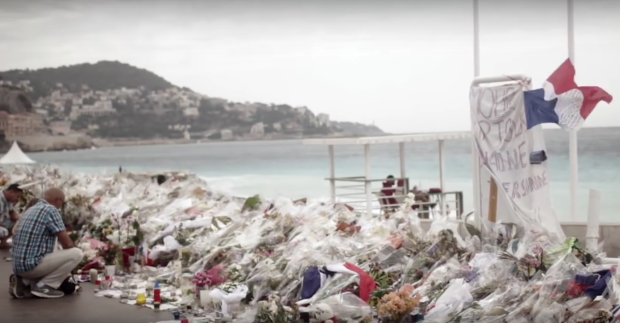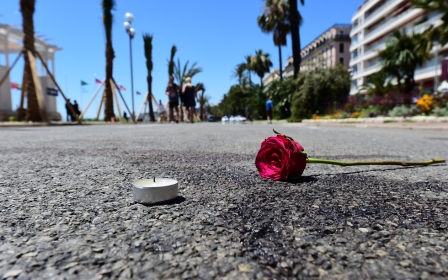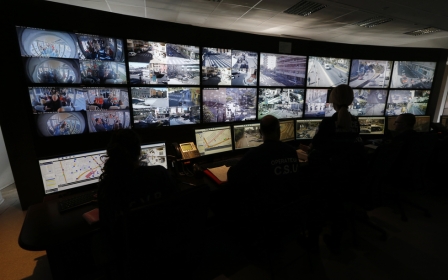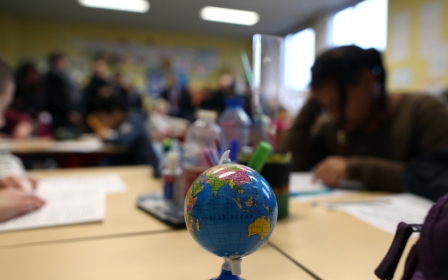
After Nice: Grief and disgrace
Since the Bastille Day atrocity in Nice, there’s a feeling of déjà vu, but no lessons have been learned.
I don’t know any person who didn’t stay up all night on 14 July. In the beginning, it was for all the usual right reasons, the summer time, the holidays, celebrations, and fireworks then, as the first videos began to trend on social media, the mood was no longer of celebration but of questions about what was happening in Nice, then for feeling concerned, sad and finally to be angry if not enraged at seeing once again people die by the dozens and to watch a cloud of vultures ready to make profit from this tragedy.
That night, a truck ploughed a crowd and killed 84 people among which 10 children and at the time of writing nearly 20 are still under intensive care. So within 18 months, over 200 people were killed by the murderous madness of a handful, who made no distinction between their victims.
The driver, Mohammed Louhaiej, was a 31-year-old man from Tunisia with psychiatric issues and cut off from all his relatives. Described as mentally unstable, his ex-wife had left him after accusing him of abuse. In 2004, he was treated for severe depression and according to the recent testimony of his father, he had stopped taking his medication and had become more and more violent with time.
After his wife left him, his entourage reported that he kept saying “she will soon hear from me”. No one knows whether he was referring to the attack he was going to carry out in the city of Nice. His actions and his first name, Mohammed, were nevertheless sufficient to turn him into a terrorist and not a psycho who wanted to commit suicide and take as many lives with him as possible.
The very same night we were counting the dead from his action and were calling our relatives to know if they were safe, national television and 24/7 news outlets, among which BFM TV represents the ultimate embarrassment, did not hesitate to turn the tragedy into a competition for ratings. They did not mind talking without facts, like calling the attack a terrorist one claimed by IS or handing the microphone to man in a state of shock, while sitting next to his dead mother, to ask how he felt.
The disgraceful coverage of the event continued all night with an “expert” on terrorism, who seemed a bit befuddled as he kept hammering the message that there was a Muslim threat in France and the goal of this attack, as requested by the self-proclaimed Islamic State (IS), was to kill as many French non-Muslims as possible. It’s as if the driver knew the religion of the people he was knocking down at 60 miles per hour. After reconstruction of the crime scene, it turned out that the first person he deliberately targeted was a veiled Muslim woman standing on the curb.
Over the phone, my relatives were giving little reassuring news. Then, once their safety was confirmed, one had to worry about their mental health. One of them, Jonathan, informed me that he knew several of the victims including his best friend’s mother. Another, Feiza Ben Mohammed, was on the Promenade des Anglais while the truck was ploughing into the crowd and informed me that she too knew many of the victims who were lying on the road. Several hours passed before we heard that the crime scene was secured and that rescue teams could do their job.
Given what has been going on in France since January 2015 and the multiple terrorist attacks that have targeted it, there were unavoidable questions. How come this attack could possibly take place right under the nose of the state of emergency which has been in full effect and even strengthened since November 2015? Despite all the extraordinary powers given to the executive branch of power, weakened powers of the judiciary, the passing of the law allowing mass surveillance, and despite the operation “Sentinelle” that dispatched 10,000 military men and women throughout the country, the 1400 surveillance cameras covering the city of Nice; how could a truck drive unchecked to the Promenade des Anglais where 20,000 people were watching the Bastille day celebration fireworks, and plough the crowd for over a mile? And to make things worse, it turned out that the very same truck had made several trips on the future crime scene even when trucks were prohibited in that part of the city.
Failures are obvious but they are not only safety related. The political class as a whole gave an unworthy spectacle before a country in shock. Not one lesson was learned from the January and November attacks. If one wanted to make people believe that France was waiting for a spark to turn against itself, this was the way to do it.
The political class, loyal to its own habits, did not wait to show off and to capitalise on the tragedy. On the “Les Républicains” side, former president Nicolas Sarkozy accompanied by MPs Eric Ciotti and Christian Estrosi, barons of the southern right, paraded at the local church. In the same church, the far right was represented by a member of the Le Pen family who came to pray. No one knows whether they prayed for all the victims and for the country to stand united.
On the left side of France’s political spectrum, President Francois Hollande and his two lieutenants Manuel Valls and Bernard Cazeneuve, prime minister and minister of interior, went to Nice to read their speeches on the united French republic and so on, but the general feeling was that such speeches were empty slogans with no concrete meaning. Maybe this time, as Prime Minister Manuel Valls was booed, they had a grasp how fed up people are of politicians being out of touch.
Denied the right to mourn
If white Christian or atheist France managed to recollect and mourn the dead, Muslim France was once again ignored. A few hundred meters away from the crime scene, the Ennour Mosque, which opened to the public less than two months ago despite staunch opposition from then Nice mayor Christian Estrosi, spent the whole week organising funeral prayers. No official showed up for the ceremonies nor showed support. According to the testimonies from attendees, several families of victims were pressured to have the ceremonies held in other places of worship.
Muslims are still praying alone for their dead, be it a mother, a son, a brother or sister, a husband or friend. Furthermore, when they showed up at the Promenade des Anglais for the public commemoration, sons and daughters of victims were assaulted by the crowd. The hatred of Arabs and Muslims is so mainstream in the city of Nice that many of its inhabitants expressed their “joy at seeing Muslims” among the lifeless bodies lying on the pavement.
What to say about the assaults against women who were identified as Arab or of Muslim descent? What to do about the shameful videos showing the daughter of the victim saying: “My mother was killed and she can’t be both a victim and responsible”. When IS preaches the destruction of the grey zone or making it impossible for Muslims and non-Muslims to peacefully coexist in the West, the loud reaction of racists will only strengthen the terrorist group in its belief that it can spark a civil war in France.
What to say about the prime minister of France who couldn’t refrain from hammering his usual rhetoric of a widespread Islamist threat in France even before the first elements of the investigation were made available? This same stance was taken by many in the US. While US Homeland Security denied the existence of links between Omar Mateen and IS, many jumped on the bandwagon and declared him to be acting on behalf of the group. The reason? His Muslim name was sufficient to make the connection despite all available information, whereas had he been a non-Muslim white person, he would have been declared a mass shooter or “just” a psycho acting alone.
Nevertheless, IS are not a bunch of idiots and did claim responsibility for the Nice attack as they had done for the Orlando night club shooting - before taking that back once they discovered Omar Mateen was bisexual. Two days after the attack, it turned out that Nice culprit Mohammed Lahouaiej was also bisexual and we wouldn’t be surprised to see the terrorist organisation backing off again.
As French sociologist Farhad Khosrokhavar wrote, the case of Mohammed Lahouaiej has more to do with psychiatry than with ideology and these claims made by the group without any proven link with the culprit “give a franchise to act for unstable people”. But that does not seem to fit the dominant discourse. The country needs a culprit, and since this one is dead, his first name is sufficient to point fingers at Muslims.
The spectacle observed in France in the aftermath of the Nice attack and even more so after the slaughter of father Jacques Himmel shows that, even in times of grief, the country is incapable of standing together and to recognise that, at least in the face of death, its inhabitants are all equal. In fact, by looking at mainstream media coverage, commentators from the right and the left as well as their respective extremes, have managed to send the common message that some lost lives are less worthy than some others. Despite all facts, Islam and the community that practices it is again under the spotlight with debates on the place of “the hijab”, “mosques”, “imams” or even the mere visibility of Muslims in French society.
The country is falling into the trap set by IS and there are reasons to believe that some aren’t too unhappy about it. It takes an extraordinary amount of courage to hold a clear-headed discourse in times of national hysteria.
As during the November attacks and the ones before it, Muslims have once more been deprived of their right to grieve and as usual, they were denied the right to speak for themselves. Of course, the establishment chooses representatives flocking into radio and TV stations to speak on their behalf, but they only spoke for themselves. The absence of the average Muslim citizen from the public sphere perpetuates their dehumanisation and further legitimises the rampant Islamophobia they deal with on a daily basis.
Two faces of Nice
A few days after the Nice massacre, I went to visit the city so I could directly speak with the local Muslim community and let them speak for themselves. After two days long and at times intense interviews with mosque attendants, community leaders and the local imam, I left the city with the feeling that this country is only waiting for a spark to set itself ablaze.
They all shared their insight on how racism is rampant in Nice and profoundly anchored is the reality of a two-faced Nice: the one with project buildings, the disgraceful high rates of unemployment, discrimination and public hate speech, a population that is left out and despised by the local elites; and then the Nice of the Promenade des Anglais, its blue waters, its fancy hotels and postcard landscape which, a few blocks away turns out to be a mirage when poverty and exclusion become visible.
When asked to put a word on their feelings since 14 July, the people on this video came up with “fear”, “anxiety”, “state of shock”. Once again, being Muslim deprives you of your right to feel human and feel what humans are supposed to feel in the aftermath of a tragedy. Regardless of the staggering proportion of Muslim victims, over 30 out of 84, and even if the first victim to be killed was a veiled Muslim woman whose name was Fatima, France’s Muslim citizens are nevertheless in the position of a suspect community.
While walking on the Promenade des Anglais, a man came up to me and insisted on expressing his condolences because he thought I was “that young man who was crying next to his dead mother”. When I told him that it wasn’t me, he continued to share his feelings on his fear of tomorrow and that as a devout Catholic man, he found strength in praying but nevertheless admitted that for him, France won’t get any better. Like many people, he also believes that the country “does not have real leaders capable of uplifting it and uniting it”.
Maybe the solution resides in everyday people standing together and acknowledging that a trap is being set by IS and the like and that our governments are not helping; be it through the bombing of civilians as France and the US did in Manbij, Syria that killed 167 people, or fuelling the narrative of a clash of civilisations at home.
When the terrorist organisation openly calls for the destruction of the grey zone, i.e. the area of peaceful coexistence between Muslims and non-Muslims in the Western hemisphere, Islamophobes are nothing short of being the useful idiots making it happen. As everyday people are the first targets of terror attacks, it may be time for everyday people to stand together and learn to look beyond their unavoidable differences if they want to outlive international terrorism. The solution will not come from the government or from the elites in general.
- Yasser Louati is a French human rights and civil liberties activist. His work focuses on Islamophobia, national security policies and social justice for minorities. You can follow him on Twitter @yasserlouati
The views expressed in this article belong to the author and do not necessarily reflect the editorial policy of Middle East Eye.
Photo: A screengrab from the short film "Nice: Grief and disgrace - Facing hatred while mourning the dead" (Yasser Louati).
Middle East Eye propose une couverture et une analyse indépendantes et incomparables du Moyen-Orient, de l’Afrique du Nord et d’autres régions du monde. Pour en savoir plus sur la reprise de ce contenu et les frais qui s’appliquent, veuillez remplir ce formulaire [en anglais]. Pour en savoir plus sur MEE, cliquez ici [en anglais].


